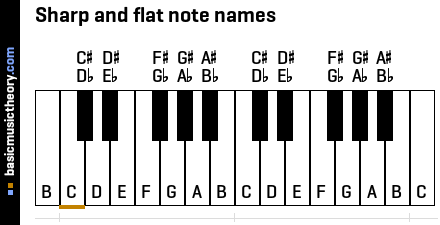Learning the Piano: Lesson 4 - Black Keys (Sharps and Flats)
Nathan Cheng
How to Play Popular Piano in 10 Easy Lessons, Norman Monath
The next step in the journey of learning a piano is to learn about the intricacies of of sharps and flats. The sharp/flat notes are located on the black keys of the piano. Having no name themselves, their titles are derived from their surrounding notes (Monath 49). For instance, a black key in between the A and B notes would be interchangeably called A sharp or B flat.
 |
| Note how the black keys have two names-- One denoting a half-step down (flat) from the higher note and one denoting a half-step up (Sharp) from the lower note |
Consequentially, sharps and flats have their own symbols in sheet music to let the musician know to play a note either sharp, flat, or natural (to not be sharp or flat).
 |
| Symbols from left to right: sharp, flat, natural |
Also, a composer may want a note in an entire song to be flatted or sharped, so they may write instructions in the key signature. When referring to these unique key signatures Norman Monath writes, "The most commonly used key signatures you will come across... are the following seven" (Monath 52). The graphic that illustrates what he means is below.
 |
| Seven most common key signatures |
With all this in mind, Monath provides examples of different renditions of songs in different key signatures. This indicates to the student that while the renditions contain different notes, they have the same sound in relation to each other.
 |
| Renditions of "Twinkle, Twinkle, Little Star" |
 |
| One of my attempts at the different renditions |
All in all, I think that the addition of black keys into my knowledge of the piano will help me in learning more complex songs. It was quite fun to play music with the same rhythm with different notes but still have the same result of a familiar melody. My question is, have you ever committed yourself to doing something that requires a lot of patience to master?
Monath, Norman. How to Play Popular Piano in 10 Easy Lessons. Simon & Schuster, 1994.





Hey Nathan, I really enjoyed reading your blog post! It was nice to read about how composers use sharps and flats and how you're learning them with the piano, so kudos for that! As for your question, I think that everything takes time and patience to master, and we haven't quite reached the age to master anything (nothing against those who believe they have). With me, I've been dedicated to playing the cello and building gunpla for several years, hoping to improve my skills. I'm nowhere near the level of "master" but I'm hoping to get there!
ReplyDeleteGood to hear from you Fadila! It's nice to hear some input from a musician that plays a string instrument. I definitely agree with you, as you masterfully voiced that we are nowhere near the age/experience of even considering the idea that we have mastered our instruments.
DeleteHello Nathan, great blog post, it really showed your determination and motivation to play the piano. As someone who used to play an instrument i can tell you i lost interest in playing very quickly and couldn't be bothered to continue going and practicing. Could you give any tips on how to stay motivated?
ReplyDelete